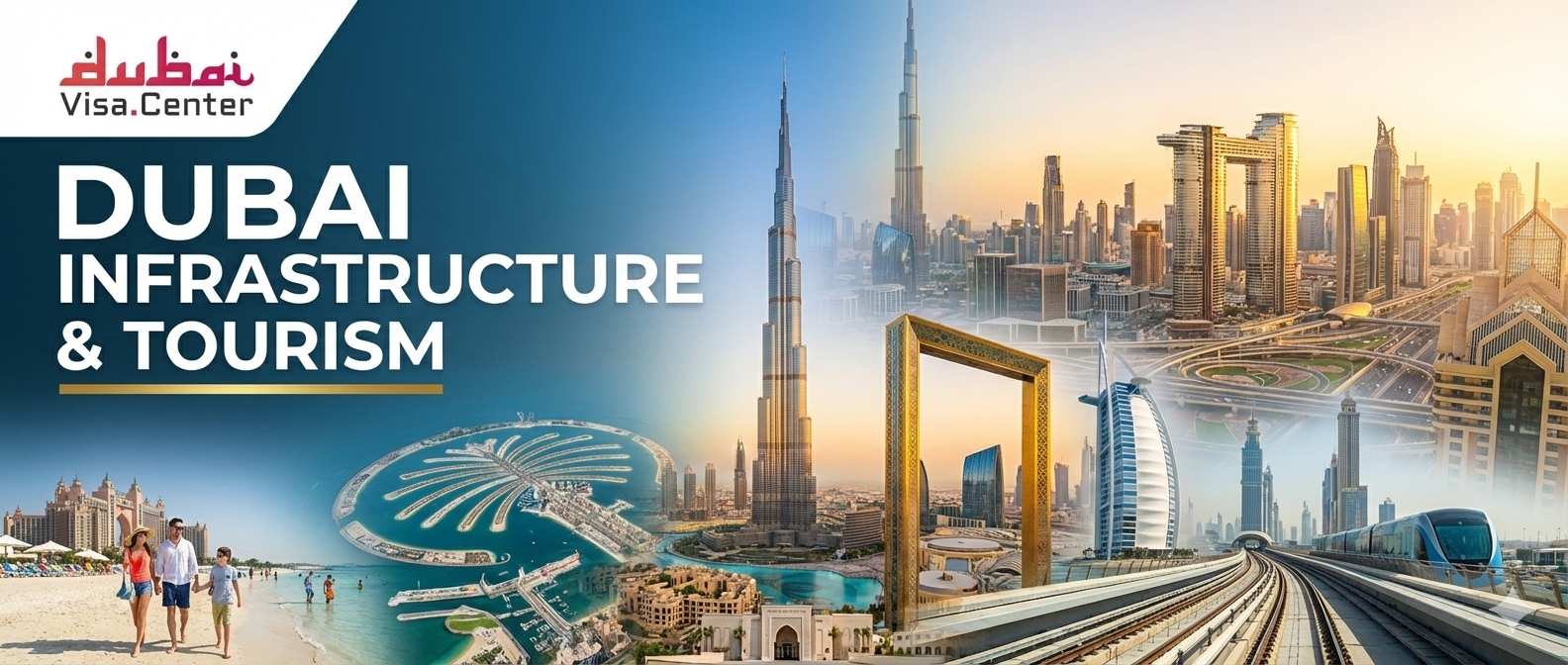Dubai is a masterclass in purposeful city-building. In 2026, travelers find a destination where record-breaking architecture, smart mobility, and heritage neighborhoods live side by side. This guide upgrades the original article with a clear, accurate overview of how Dubai’s infrastructure evolved, the must-see places, how to move around efficiently, and a simple visa path through Dubai Visa Center.
Dubai at a Glance: Why It Leads Global Urban Tourism in 2026
-
World-class connectivity (DXB & DWC airports) and seamless visas.
-
Iconic skyline anchored by super-tall towers and engineering firsts.
-
Visitor-centric planning: shaded promenades, waterfronts, malls, transit links.
-
Year-round calendar of festivals, sports, culture, and retail events.
The Roots of Dubai: From Creek Settlement to Global City
Early Trade, Pearling & Coastal Settlements
Dubai’s story begins on and around Dubai Creek, where Bani Yas tribes developed a trading hub linked to the Gulf and Indian Ocean. Pearling, fishing, and caravan routes shaped the city’s earliest economy.
Oil Era to Diversified Economy: Tourism, Trade & Services
Oil revenues funded ports, roads, and utilities, but long-term strategy prioritized trade, logistics, finance, real estate, and tourism—laying the groundwork for today’s visitor-ready city.
Infrastructure: Then vs Now
1970s–1990s: Ports, Roads & Early Urban Growth
-
Deep-water seaports enabled import/export and regional distribution.
-
Road networks connected the emirates and fostered urban expansion.
2000s–2026: Smart Mobility, Super-tall Architecture & Visitor Infrastructure
-
Metro, tram, and bus systems reduce car dependence.
-
Transit-linked districts (Downtown, Dubai Marina, Expo City) ease sightseeing.
-
Smart services (e-payments, wayfinding, Nol cards) improve visitor flow.
Top Modern Landmarks & Cultural Sites to See in 2026
Super-Tall & Signature Icons
-
Burj Khalifa – the world’s tallest tower; observation decks on multiple levels.
-
Cayan Tower – a striking, twisted residential skyscraper in Dubai Marina.
-
Princess Tower & Emirates Towers – emblematic high-rises of the skyline.
Note: Some attractions can have seasonal maintenance/operational pauses—always check current status when planning.
Culture, Faith & Heritage
-
Jumeirah Mosque – among the most photographed mosques in Dubai; cultural tours available.
-
Grand Mosque (Al Fahidi) & Al Fahidi Historical District – wind-towers, galleries, museums.
-
Hindu temples (Bur Dubai) and Jain temple – reflecting Dubai’s multicultural fabric.
Waterfronts, Frames & Futuristic Museums
-
Dubai Frame – panoramic views linking “old” and “new” Dubai.
-
Creek & Marina promenades – dining, public art, and sunset walks.
-
Contemporary museums & cultural centers – showcasing innovation and design.
How Infrastructure Fuels Tourism in 2026
Connected Airports, Metro & Roads
Integrated planning gets you from airport to hotel to attractions quickly and affordably. Metro links to Downtown and Marina cut taxi time and cost.
Events, Malls, Beaches & Desert Experiences
Shoppers, beach-seekers, and desert-adventurers all benefit from well-signed highways, beach facilities, and tourist services clustered near transit.
Sustainability & Responsible Travel
Expect recycling programs, green building standards, and a push toward clean energy—choose refillable bottles, metro travel, and eco-certified tours where possible.
Getting Around: Practical Transport Tips
Metro, Tram, Buses & Nol Cards
-
Buy a Nol card for pay-as-you-go travel across metro, tram, and buses.
-
Peak sightseeing lines: Red Line (Burj Khalifa/Dubai Mall, Marina/JBR).
-
Tram connects Marina–JBR; buses fill last-mile gaps.
Taxis, E-Hailing & Driving Etiquette
-
Official taxis are metered; e-hailing apps are widely used.
-
Use designated pick-up points at malls and attractions.
-
Observe lane discipline and speed limits if you rent a car.
Visa Basics for 2026: Simple Steps to Enter Dubai
Tourist Visa Types & Validity
-
30-day and 90-day tourist visas (single/multiple-entry).
-
Transit visas (48/96 hours) for stopovers.
-
Multi-entry options suit frequent visitors.
Document Checklist
-
Passport valid 6+ months, clear bio-page scan.
-
Passport photo (white background).
-
Flight booking (return/onward).
-
Hotel booking or host details.
-
Travel insurance covering UAE.
Processing Time & Extensions
-
Typical processing: 2–4 working days (may vary in peak seasons).
-
Many tourist visas allow two 30-day extensions without exit (rules can vary by category—check at time of application).
Risks to Avoid: Unverified Agents, Wrong Paperwork & Hidden Fees
-
Submitting blurry scans or incomplete forms causes delays or refusals.
-
Unverified agents may overcharge or mishandle documents.
-
Mismatched hotel/flight dates can trigger rework or rejection.
Play it safe: apply through a registered, experienced provider.
Why Apply with Dubai Visa Center
-
Step-by-step guidance and document checks that reduce errors.
-
Fast processing with proactive status updates.
-
Transparent pricing and 24/7 support via chat/email/phone.
👉 Apply for your Dubai Visa online now with Dubai Visa Center and plan your itinerary with confidence.
Conclusion & CTA: Plan, Apply, and Explore Dubai Smarter in 2026
Dubai’s journey—from Creek-side trading post to a globally admired smart city—shows up in every metro line, museum, beach boardwalk, and skyline view. With infrastructure designed for visitors and residents alike, your 2026 trip can be seamless.
Next step:
👉 Start your Dubai Visa application with Dubai Visa Center today and unlock a smoother, smarter way to experience Dubai’s best landmarks and culture.

Leave a comment
Your email address will not be published. Required fields are marked *